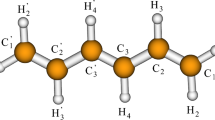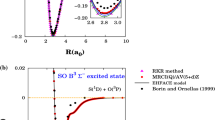Abstract
Singlet–triplet adiabatic excitation energies (AES−T) of the parent and variously substituted phenyl cations, as well as the parent benzannelated derivatives up to anthracenyl, were calculated at the G4(MP2) and G4 levels of theory. The G4(MP2)/G4 AES−T estimates range up to 40 kJ/mol higher than prior density functional theory (DFT)-based predictions for these cations and suggest that AES−T and ground state multiplicity structure–property trends for phenyl cations previously proposed in the literature need to be re-assessed at higher levels of theory. In general, Hartree–Fock, DFT, and semiempirical methods do a poor job describing the singlet–triplet excitation energetics of these systems. Only modest effects of different solvation models (SMD, IEF-PCM, and C-PCM) and different polar protic through apolar aprotic solvents are evident on the calculated AES−T of the phenyl cation. Electron-donating substituents on the phenyl cation substantially lower the AES−T to an extent where some functional groups (–NH2, N(CH3)2, OCH3, and SCH3) can result in triplet ground states depending on their position relative to the cation. In contrast to the phenyl and 1- and 2-naphthyl cations, which are predicted to be ground state singlets, the three parent anthracenyl cations will be ground state triplets.


Similar content being viewed by others
References
Lewis ES (1958) Reactivity of the phenyl cation in solution. J Am Chem Soc 80:1371–1373
Taft RW (1961) Evidence for phenyl cation with an odd number of π-electrons from the aqueous thermal decomposition of the diazonium ion. J Am Chem Soc 83:3350–3351
Swain CG, Sheats JE, Harbison KG (1975) Evidence for phenyl cation as an intermediate in reactions of benzenediazonium salts in solution. J Am Chem Soc 97:783–790. doi:10.1021/ja00837a016
Guizzardi B, Mella M, Fagnoni M, Albini A (2003) Photochemical reaction of N, N-dimethyl-4-chloroaniline with dienes: new synthetic paths via a phenyl cation. Chem Eur J 9:1549–1555
Bergstrom RG, Landells RGM, Wahl GH, Zollinger H (1976) Dediazoniation of arenediazonium ions in homogeneous solution. 7. On the intermediacy of the phenyl cation. J Am Chem Soc 98:3301–3305
Ambroz HB, Kemp TJ (1979) Aryl cations—new light on old intermediates. Chem Soc Rev 8:353–365. doi:10.1039/CS9790800353
Harvey JN, Aschi M, Schwarz H, Koch W (1998) The singlet and triplet states of phenyl cation. A hybrid approach for locating minimum energy crossing points between non-interacting potential energy surfaces. Theor Chem Acc 99:95–99. doi:10.1007/s002140050309
Hrusak J, Schröder D, Iwata S (1997) The ground state (1A1) and the lowest triplet state (3B1) of the phenyl cation C6H5 + revisted. J Chem Phys 106:7541–7549. doi:10.1063/1.473757
Rayne S, Forest K (2012) Singlet–triplet excitation energies of naphthyl cations: high level composite method calculations suggest a singlet ground state. Comput Theor Chem 983:69–75. doi:10.1016/j.comptc.2012.01.005
Winkler M, Sander W (2000) Isolation of the phenyl cation in a solid argon matrix. Angew Chem Int Ed 39:2014–2016. doi:10.1002/1521-3773(20000602)39:11<2014:AID-ANIE2014>3.0.CO;2-E
Winkler M, Sander W (2006) Generation and reactivity of the phenyl cation in cryogenic argon matrices: monitoring the reactions with nitrogen and carbon monoxide directly by IR spectroscopy. J Org Chem 71:6357–6367. doi:10.1021/jo0603678
Ambroz HB, Przybytniak GK, Stradowski CZ, Wolszczak M (1990) Optical spectroscopy of the aryl cation, the intermediate in the decomposition of arenediazonium salts. J Photochem Photobiol Chem 52:369–374
Patzer A, Chakraborty S, Solcà N, Dopfer O (2010) IR spectrum and structure of the phenyl cation. Angew Chem Int Ed 49:10145–10148. doi:10.1002/anie.201006357
Scaiano JC, Kim-Thuan N (1983) Diazonium salts in photochemistry III. Attempts to characterize aryl cations. J Photochem 23:269–276
Aschi M, Harvey JN (1999) Spin isomerisation of para-substituted phenyl cations. J Chem Soc Perkin Trans 2:1059–1062
Dill JD, Schleyer PVR, Pople JA (1977) Molecular orbital theory of the electronic structure of molecules. 31. Substituent stabilization of the phenyl cation. J Am Chem Soc 99:1–8
Milanesi S, Fagnoni M, Albini A et al (2003) Cationic arylation through photo(sensitised) decomposition of diazonium salts. Chemoselectivity of triplet phenyl cations. Chem Commun 216–217
Protti S, Dichiarante V, Dondi D et al (2012) Singlet/triplet phenyl cations and benzyne from the photodehalogenation of some silylated and stannylated phenyl halides. Chem Sci 3:1330–1337. doi:10.1039/c2sc20060k
Slegt M, Overkleeft HS, Lodder G (2007) Fingerprints of singlet and triplet phenyl cations. Eur J Org Chem 32:5364–5375. doi:10.1002/ejoc.200700339
Apeloig Y, Arad D (1985) Stabilization of the phenyl cation by hyperconjugation. J Am Chem Soc 107:5285–5286. doi:10.1021/ja00304a049
Nicolaides A, Smith DM, Jensen F, Radom L (1997) Phenyl radical, cation, and anion. The triplet–singlet gap and higher excited states of the phenyl cation. J Am Chem Soc 119:8083–8088. doi:10.1021/ja970808s
Gronert S, Keeffe JR, More O’Ferrall RA (2011) Stabilities of carbenes: independent measures for singlets and triplets. J Am Chem Soc 133:3381–3389. doi:10.1021/ja1071493
Winter AH, Falvey DE (2010) Vinyl cations substituted with beta π-donor have triplet ground states. J Am Chem Soc 132:215–222
Zhou X, Hrovat DA, Gleiter R, Borden WT (2009) Reinvestigation of the ordering of the low-lying electronic states of cyclobutanetetraone with CASPT2, CCSD(T), G3B3, ccCA, and CBS-QB3 calculations. Mol Phys 107:863–870. doi:10.1080/00268970802672650
Woodcock HL, Moran D, Brooks BR et al (2007) Carbene stabilization by aryl substituents. Is bigger better? J Am Chem Soc 129:3763–3770. doi:10.1021/ja068899t
Rayne S, Forest K (2011) A comparison of density functional theory (DFT) methods for estimating the singlet–triplet (S0–T1) excitation energies of benzene and polyacenes. Comput Theor Chem 976:105–112. doi:10.1016/j.comptc.2011.08.010
Rayne S, Forest K (2011) Singlet–triplet (S0 → T1) excitation energies of the [4 × n] rectangular graphene nanoribbon series (n = 2–6): a comparative theoretical study. Comput Theor Chem 977:163–167. doi:10.1016/j.comptc.2011.09.021
Curtiss LA, Redfern PC, Raghavachari K (2007) Gaussian-4 theory using reduced order perturbation theory. J Chem Phys 127:124105. doi:10.1063/1.2770701
Curtiss LA, Redfern PC, Raghavachari K (2007) Gaussian-4 theory. J Chem Phys 126:084108. doi:10.1063/1.2436888
Barnes EC, Petersson GA, Montgomery JA et al (2009) Unrestricted coupled cluster and Brueckner doubles variations of W1 theory. J Chem Theory Comput 5:2687–2693. doi:10.1021/ct900260g
Frisch MJ, Trucks GW, Schlegel HB et al (2009) Gaussian 09, revision D01. Gaussian Inc, Wallingford
Peverati R, Truhlar DG (2012) An improved and broadly accurate local approximation to the exchange–correlation density functional: the MN12-L functional for electronic structure calculations in chemistry and physics. Phys Chem Chem Phys 14:13171–13174. doi:10.1039/c2cp42025b
Peverati R, Truhlar DG (2012) Screened-exchange density functionals with broad accuracy for chemistry and solid-state physics. Phys Chem Chem Phys 14:16187–16191. doi:10.1039/C2CP42576A
Peverati R, Truhlar DG (2012) M11-L: a local density functional that provides improved accuracy for electronic structure calculations in chemistry and physics. J Phys Chem Lett 3:117–124. doi:10.1021/jz201525m
Peverati R, Truhlar DG (2011) A global hybrid generalized gradient approximation to the exchange–correlation functional that satisfies the second-order density-gradient constraint and has broad applicability in chemistry. J Chem Phys 135:191102. doi:10.1063/1.3663871
Austin A, Petersson GA, Frisch MJ et al (2012) A density functional with spherical atom dispersion terms. J Chem Theory Comput 8:4989–5007. doi:10.1021/ct300778e
Henderson TM, Izmaylov AF, Scuseria GE, Savin A (2008) Assessment of a middle-range hybrid functional. J Chem Theory Comput 4:1254–1262. doi:10.1021/ct800149y
Weigend F, Ahlrichs R (2005) Balanced basis sets of split valence, triple zeta valence and quadruple zeta valence quality for H to Rn: design and assessment of accuracy. Phys Chem Chem Phys 7:3297–3305. doi:10.1039/b508541a
Weigend F (2006) Accurate Coulomb-fitting basis sets for H to Rn. Phys Chem Chem Phys 8:1057–1065. doi:10.1039/b515623h
Grimme S (2006) Semiempirical GGA-type density functional constructed with a long-range dispersion correction. J Comput Chem 27:1787–1799
Grimme S, Ehrlich S, Goerigk L (2011) Effect of the damping function in dispersion corrected density functional theory. J Comput Chem 32:1456–1465
Marenich AV, Cramer CJ, Truhlar DG (2009) Universal solvation model based on solute electron density and on a continuum model of the solvent defined by the bulk dielectric constant and atomic surface tensions. J Phys Chem B 113:6378–6396. doi:10.1021/jp810292n
Tomasi J, Mennucci B, Cammi R (2005) Quantum mechanical continuum solvation models. Chem Rev 105:2999–3093. doi:10.1021/cr9904009
Scalmani G, Frisch MJ (2010) Continuous surface charge polarizable continuum models of solvation. I. General formalism. J Chem Phys 132:114110. doi:10.1063/1.3359469
Cossi M, Rega N, Scalmani G, Barone V (2003) Energies, structures, and electronic properties of molecules in solution with the C-PCM solvation model. J Comput Chem 24:669–681. doi:10.1002/jcc.10189
Barone V, Cossi M (1998) Quantum calculation of molecular energies and energy gradients in solution by a conductor solvent model. J Phys Chem A 102:1995–2001. doi:10.1021/jp9716997
Allouche A-R (2011) Gabedit: a graphical user interface for computational chemistry softwares. J Comput Chem 32:174–182
Hanwell MD, Curtis DE, Lonie DC et al (2012) Avogadro: an advanced semantic chemical editor, visualization, and analysis platform. J Cheminform 4:17. doi:10.1186/1758-2946-4-17
Dill JD, Schleyer PR, Binkley JS et al (1976) Molecular orbital theory of the electronic structure of molecules. 30. Structure and energy of the phenyl cation. J Am Chem Soc 98:5428–5431. doi:10.1021/ja00434a002
Lazzaroni S, Dondi D, Fagnoni M, Albini A (2008) Geometry and energy of substituted phenyl cations. J Org Chem 73:206–211. doi:10.1021/jo7020218
Laali KK, Rasul G, Prakash GKS, Olah GA (2002) DFT study of substituted and benzannelated aryl cations: substituent dependency of singlet/triplet ratio. J Org Chem 67:2913–2918. doi:10.1021/jo020084p
Bondarchuk SV, Minaev BF (2011) Density functional study of ortho-substituted phenyl cations in polar medium and in the gas phase. Chem Phys 389:68–74. doi:10.1016/j.chemphys.2011.08.005
Hansch C, Leo A, Taft RW (1991) A survey of Hammett substituent constants and resonance and field parameters. Chem Rev 91:165–195. doi:10.1002/chin.199139332
Cox A, Kemp TJ, Payne DR et al (1978) Electron spin resonance characterization of ground state triplet aryl cations substituted at the 4 position by dialkylamino groups. J Am Chem Soc 100:4779–4783
Ambroz HB, Kemp TJ, Przybytniak GK (1997) Unusual features in the triplet state EPR spectrum of 3,5-dichloro-4-aminophenyl cation. J Photochem Photobiol Chem 108:149–153
Ambroz HB, Kemp TJ (1979) Triplet state E.S.R. studies of aryl cations. Part 2. Substituent factors influencing net stabilisation of the triplet level. J Chem Soc Perkin Trans 2:1420–1424
Ambroz HB, Kemp TJ, Przybytniak GK (1992) Optical spectroscopy of the aryl cation. 3. Substituent effects on the production and electronic spectra of intermediates in the photodecomposition of ArN2 +; optical characterization of the reaction Ar+ + N2 –> ArN2 +. J Photochem Photobiol Chem 68:85–95
Momeni MR, Shakib FA (2011) Theoretical description of triplet silylenes evolved from H2Si═Si. Organometallics 30:5027–5032. doi:10.1021/om200586d
Bondarchuk SV, Minaev BF (2010) About possibility of the triplet mechanism of the Meerwein reaction. J Mol Struct Theochem 952:1–7. doi:10.1016/j.theochem.2010.04.025
Acknowledgments
This work was made possible by the facilities of the Western Canada Research Grid (WestGrid: project 100185), the Shared Hierarchical Academic Research Computing Network (SHARCNET: project sn4612), and Compute/Calcul Canada.
Author information
Authors and Affiliations
Corresponding author
Rights and permissions
About this article
Cite this article
Rayne, S., Forest, K. Singlet–triplet excitation energies of substituted phenyl cations: a G4(MP2) and G4 theoretical study. Theor Chem Acc 135, 69 (2016). https://doi.org/10.1007/s00214-016-1837-5
Received:
Accepted:
Published:
DOI: https://doi.org/10.1007/s00214-016-1837-5




